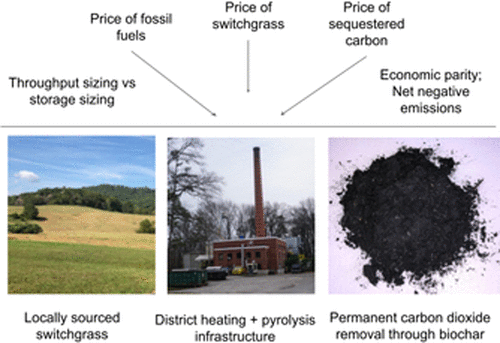RE: [Biochar] new article on PYCCS
Anderson, Paul
Congratulations to Jeff Waldon and his co-authors of a new article. The link is below (also goes to Supplemental materials) and to the ways to access this item that is behind a $40 pay-wall. So I have placed the abstract below and then I make additional comments marked >PSA.
See https://pubs.acs.org/doi/10.1021/acs.est.1c03478 for new article from Virginia Tech on PYCCS.
Technoeconomic Analysis of Negative Emissions Bioenergy with Carbon Capture and Storage through Pyrolysis and Bioenergy District Heating Infrastructure
- Theodore Chao Lim*
,
- Amanda Cuellar
,
- Kyle Langseth
, and
- Jefferson L. Waldon
Cite this: Environ. Sci. Technol. 2022, XXXX, XXX, XXX-XXX
Publication Date:January 11, 2022
https://doi.org/10.1021/acs.est.1c03478
© 2022 American Chemical Society
Supporting Info (1)»Supporting Information
SUBJECTS:
Environmental Science & Technology
Abstract

>>PSA comments: The abstract below introduces new names and acronyms that IMO will need so further clarification. Several persons (including me) have long pointed out the serious limitations of BECCS that burns the biomass all the way to ash, but should instead be replaced with pyrolytic processes. That alternative seems to be what is happening in PyBECCS and PyBE and maybe other names. If so, I am in favor of the process change but maybe not the proposed names Maybe Jeff can further distinguish between the many names. You readers can make your own decisions. But hallelujah, it looks like pyrolysis and biochar are being appropriately recognized. Congratulations to Jeff and his co-authors!! Paul
ABSTRACT
Bioenergy with carbon capture and storage (BECCS) has been identified as a cost-effective negative emission technology that will be necessary to limit global warming to 1.5 °C targets. However, the study of BECCS deployment has mainly focused on large-scale, centralized facilities and geologic sequestration. In this study, we perform technoeconomic analysis of BECCS through pyrolysis technology within a district heating system using locally grown switchgrass. The analysis is based on a unique case study of an existing switchgrass-fueled district heating system in the rural southeastern United States and combines empirical daily energy data with a retrospective analysis of add-on pyrolysis technology with biochar storage. We show that at current heating oil and switchgrass prices, pyrolysis-bioenergy (PyBE) and pyrolysis BECCS (PyBECCS) can each reach economic parity with a fossil fuel-based system when the prices of carbon is $116/Mg CO2-eq and $51/Mg CO2-eq, respectively. In addition, each can reach parity with a direct combustion bioenergy (BE) system when the prices of carbon is $264/Mg CO2-eq and $212/Mg CO2-eq, respectively. However, PyBECCS cannot reach economic parity with BE without revenue from carbon sequestration, while PyBE can, and in some cases, PyBECCS could counterintuitively require more reliance on fossil fuels than both the PyBE case and BE.
KEYWORDS:
- decarbonization
- carbon dioxide removal (CDR)
- lifecycle analysis (LCA)
- bioenergy and carbon capture and storage (BECCS)
- district heating
- switchgrass
Doc / Dr TLUD / Paul S. Anderson, PhD --- Website: www.drtlud.com
Email: psan...@ilstu.edu Skype: paultlud
Phone: Office: 309-452-7072 Mobile & WhatsApp: 309-531-4434
Exec. Dir. of Juntos Energy Solutions NFP Go to: www.JuntosNFP.org
Inventor of RoCC kilns and author of Biochar white paper : See www.woodgas.energy/resources
Author of “A Capitalist Carol” (free digital copies at www.capitalism21.org)
with pages 88 – 94 about solving the world crisis for clean cookstoves.
_._,_
